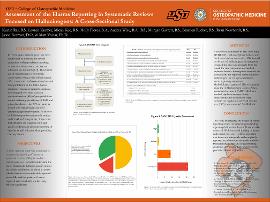| dc.contributor.author | Ray, Kaylin | |
| dc.contributor.author | Kramer, Lauren | |
| dc.contributor.author | Kee, Micah | |
| dc.contributor.author | Flores, Holly | |
| dc.contributor.author | Wise, Audrey | |
| dc.contributor.author | Garrett, Morgan | |
| dc.contributor.author | Rucker, Brayden | |
| dc.contributor.author | Newhardt, Ryan | |
| dc.contributor.author | Beaman, Jason | |
| dc.contributor.author | Vassar, Matt | |
| dc.date.accessioned | 2023-11-02T20:46:49Z | |
| dc.date.available | 2023-11-02T20:46:49Z | |
| dc.date.issued | 2023-02-17 | |
| dc.identifier | ouhd_Ray_assessmentoftheharmsreporting_2023 | |
| dc.identifier.citation | Ray, K., Kramer, L., Kee, M., Flores, H., Wise, A., Garrett, M., Rucker, B., Newhardt, R., Beaman, J., and Vassar, M. (2023, February 17). Assessment of the harms reporting in systematic reviews focused on hallucinogens: A cross-sectional study. Poster presented at Research Week, Oklahoma State University Center for Health Sciences, Tulsa, Ok. | |
| dc.identifier.uri | https://hdl.handle.net/11244/339928 | |
| dc.description.abstract | Objective: To investigate the reporting of harms in systematic reviews (SRs) focused on hallucinogen use. | |
| dc.description.abstract | Methods: A search was conducted in May 2022 using MEDLINE, Embase, Epistemonikos, and Cochrane databases to retrieve SRs focused on the use of hallucinogens. Investigators screened the titles and abstracts from the search for study inclusion in a masked, triplicate fashion. Investigators analyzed the included SRs for reported harms linked to hallucinogen use via a pre-established harms reporting assessment. Methodological quality of SRs were graded using the A MeaSurement Tool to Assess Systematic Reviews-2 (AMSTAR-2) in a masked, duplicate manner. Study characteristics for each review were extracted in duplicate. Corrected covered area (CCA) was measured for SR dyads. | |
| dc.description.abstract | Results: Our search returned 908 articles, and 32 SRs met eligibility criteria for final harms reporting analysis. Of the included reviews, 28 SRs (56.2%) indicated harms as a primary or secondary outcome, 2 SRs (6.3%) reported predetermined methods to grade, collect harms data, or statistically analyze harms. A significant relationship was found between completeness of harms reporting and whether harms were listed as a primary or secondary outcome. | |
| dc.description.abstract | Conclusion: Harms were largely underreported in scientific literature regarding hallucinogen use, despite many studies designating them as a primary or secondary outcome. Inadequate reporting is unlikely to provide credible evidence used to evaluate the benefit-harm trade-off. Therefore, steps should be taken to improve reporting of harms in studies concerning hallucinogen use. | |
| dc.format | application/pdf | |
| dc.language | en_US | |
| dc.publisher | Oklahoma State University Center for Health Sciences | |
| dc.rights | The author(s) retain the copyright or have the right to deposit the item giving the Oklahoma State University Library a limited, non-exclusive right to share this material in its institutional repository. Contact Digital Resources and Discovery Services at lib-dls@okstate.edu or 405-744-9161 for the permission policy on the use, reproduction or distribution of this material. | |
| dc.title | Assessment of the harms reporting in systematic reviews focused on hallucinogens: A cross-sectional study | |
| osu.filename | ouhd_Ray_assessmentoftheharmsreporting_2023.pdf | |
| dc.type.genre | Presentation | |
| dc.type.material | Text | |
| dc.subject.keywords | hallucinogens | |
| dc.subject.keywords | harms | |
| dc.subject.keywords | psychedelics | |
| dc.subject.keywords | adverse effects | |
